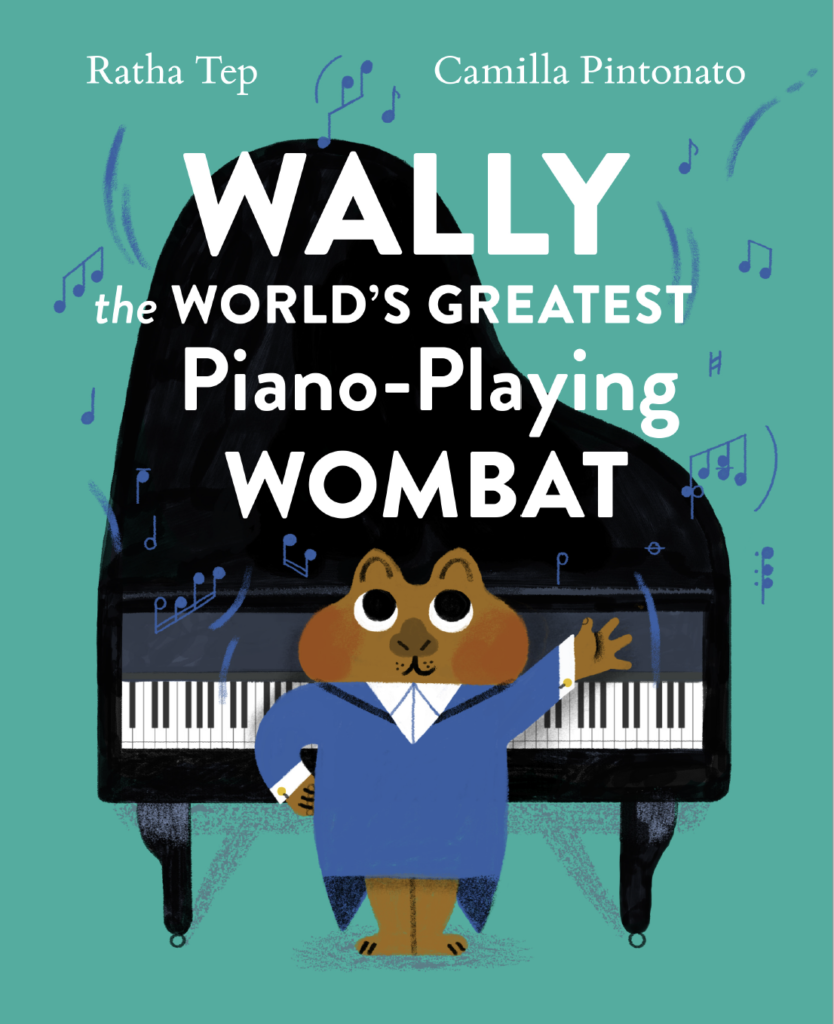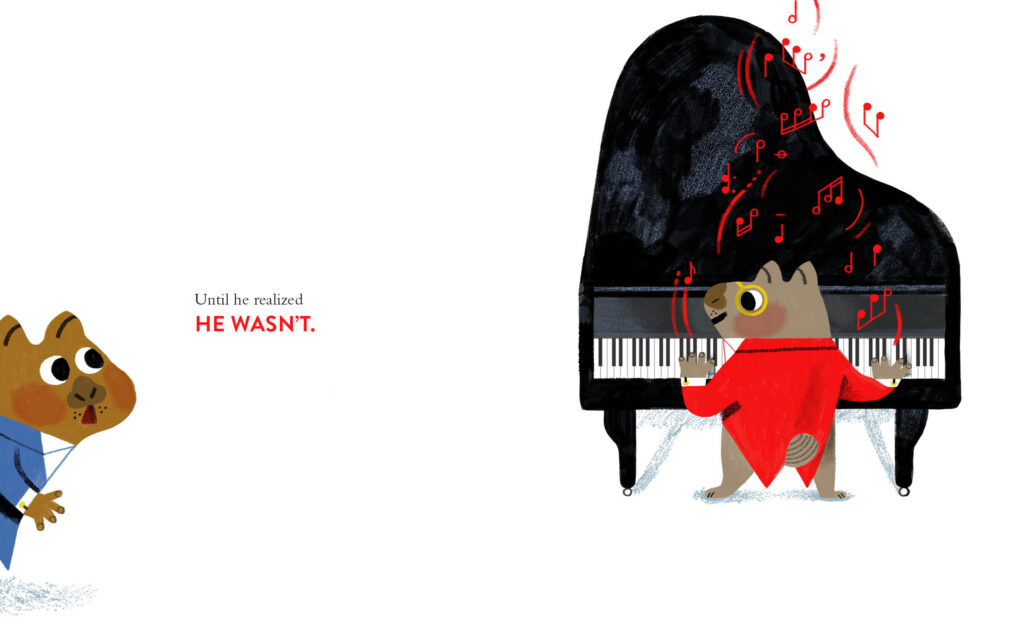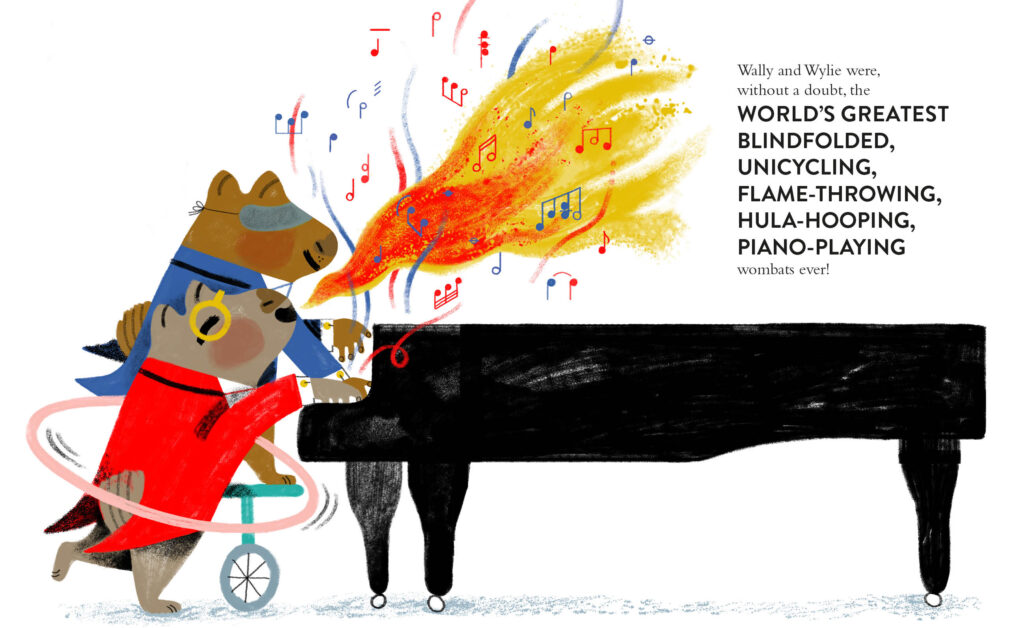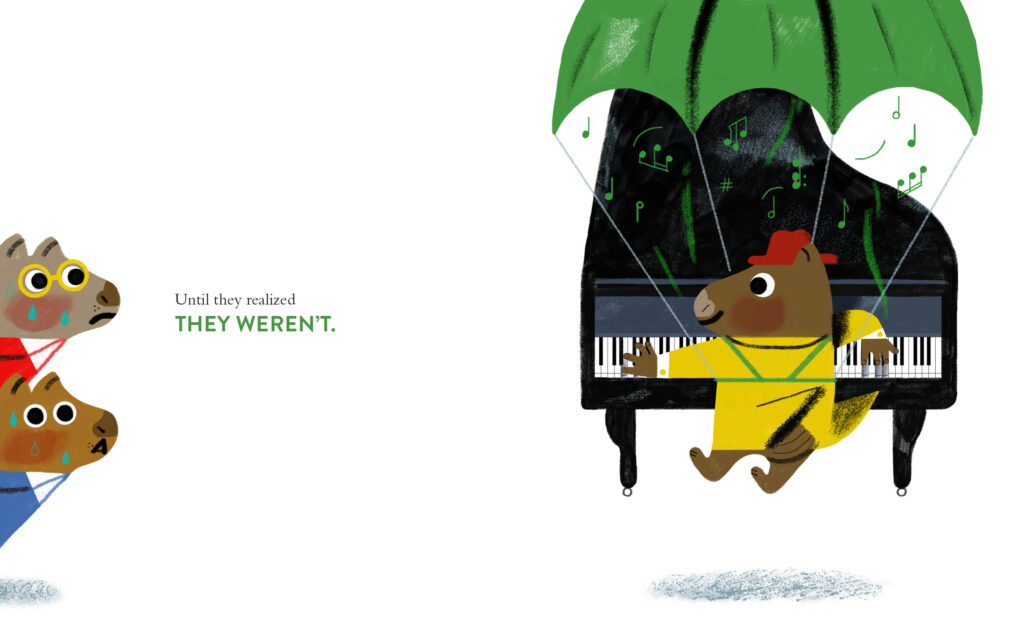
Wally was the world’s greatest piano-playing wombat—until he realized there was an even more talented piano-playing wombat in town! This funny picture book’s bright colors and imaginative musical scenes teach children to have self-confidence when faced with competition.
~Wally the World’s Greatest Piano-Playing Wombat, flap copy
Andrea: Hi Ratha! Thank you so much for stopping by the Picture Book Builders blog! Congratulations on your debut picture book, Wally the World’s Greatest Piano-Playing Wombat! I remember reading Jackie French’s hilarious Diary of a Wombat to my children years ago, which sparked a love of wombats in my family. What inspired you to make Wally a wombat, besides the wonderful alliteration?
Ratha: Hi Andrea! Thanks so much for having me on this wonderful blog! It’s truly an honor to be here. Diary of a Wombat is indeed hilarious, and I owe a huge debt to Jackie French and Bruce Whatley for introducing the wombat to a generation of American kids. Wombats are adorable, but I made Wally a wombat not so much to make him cute, but to pump up the humor. I envisioned him as a Northern hairy-nosed wombat, which is the largest of the wombat species—the kind I imagined would be able to reach piano keys. There are only 315 of them left in the world, so they’re extremely rare. If one played the piano, you would expect him to be the world’s greatest piano-playing Northern hairy-nosed wombat. But then there’s another one! And another….! (That longer title got nixed pretty quickly.)
Andrea: Wow, I just looked up Northern hairy-nosed wombats and they can reach up to 1 meter in length! In the story, Wally tries to out-do Wylie, another piano-playing wombat, with a series of increasingly funny talents, including tap dancing and ball twirling. I’m always interested in how and why an author chooses certain examples out of an almost limitless number of options. Could you talk a little about your process for deciding on these, um, skills (for lack of a better word) and if there were ones that you abandoned during the course of revision? For example, did you keep wombat anatomy or illustration potential in mind?
Ratha: I did come up with a lot more, um, “skills.” The manuscript went through a number of revisions, and in one early version, Wally and Wylie pole vault onto a tightrope, and somersault to their respective pianos before giving their grand performance. That eventually got nixed because having one big reveal for their finale delivered more of a “wow” factor than building up to it. Their talents were all so over-the-top and zany that I didn’t pay too much regard to wombat anatomy. What I mostly thought about was whether they’d make my kids laugh.

Andrea: They definitely made me laugh! And that’s a good point about how one big reveal sometimes works better than building up to it. There is a small moment earlier on that stuck with me. The moment when Wally realizes that he isn’t going to be the best piano-playing wombat and decides that, “If he couldn’t be the greatest, he wouldn’t play at all,” is so relatable. I also gave up playing the piano at a young age when I realized that I would never be as good as my friends. What would you say to competitive kids who also struggle with this kind of thinking?
Ratha: The struggle is real, and competition was particularly hard for me to deal with as a child. At a young age, I was chosen to be part of a program for gifted kids. But I couldn’t handle seeing so many other more talented kids. I internalized it all in an unhealthy way and got quite sick as a result, and ended up in the hospital. So what I would most like to say to kids struggling with competition is that I know firsthand how hard it can be. I also want them to know that envy and jealousy are normal feelings that everyone gets; what matters is how you handle them. You can harness those feelings to do better. You can collaborate. And who knows? Like Wally, you might just end up with a new friend. Things also exponentially improved for me once I started accepting that there would always be someone better. I don’t mean this in a defeatist way; if anything I find it a liberating frame of thought. It frees you up to do what you really love.
Andrea: I am so sorry that that happened to you when you were young. Thank you for the advice that changing your perspective on a situation can be freeing. This book is a wonderful–and hilarious!–depiction of the saying, “Comparison is the thief of joy.” It is SO hard, though, to not compare ourselves to others, especially as creatives and when social media shows us how our lives differ from others’. Do you have any advice for how to turn off that desire to constantly compare ourselves to other people? How do you reconnect with and find joy again in your creative work? Asking for a friend…
Ratha: Thank you! It’s interesting—I’m competitive about certain things, but not about my writing. I think it’s because it’s all so personal. I can only write the way I’m meant to write, just like someone else can write in only the way she can. Writing is also so hard—it’s pulling magic out of thin air, really—that I just find myself marveling over what others create. But I do compare myself on other things, and social media definitely makes it worse. It helps to know social media presents only one side—usually the rosy side—of the picture, so a lot of misguided assumptions can take place. It’s like Wally seeing only one side of Wylie from afar.

Andrea: Ah, that’s such a great reminder about how all our stories are important and we are the best people to write them. You’ve been a journalist for many years, writing mostly about travel and food (two of my favorite things!). How does the process of writing a picture book differ from newspaper and magazine articles, or do they overlap?
Ratha: Before Covid put a halt on travel, I was a frequent contributor to the New York Times Travel section. I loved writing newspaper articles, but I also lived in fear of a public correction. I always triple- or quadruple-checked everything I wrote since every single sentence had to be true. So writing a fictional picture book was just wild to me. It felt so crazy and fun to be able to make stuff up. Can a wombat play the piano? Not that I’ve ever heard of. Can a wombat play the piano while tap-dancing? I doubt it. Can I write a book about this? Yes, I can!
The creative process also differed in that a picture book is a dance between text and illustration. I was used to trying to capture color and texture with the written word, but I really pared everything down to give room for the art to pack its punch.
Andrea: Speaking of the art, the illustrations by Camilla Pintonato are so vivid and expressive! Do you have a favorite spread and why?
Ratha: I was blown away by Camilla’s illustrations! I especially loved how she captured such a wide range of wombat emotions, from joy and pride to exasperation and sadness. My favorite early spread was when Wally poked out from the edge of the page in shock upon seeing Wally play. It felt fourth-wall breaking in a way, as if he was just doing his thing (outside the book), and then got pulled back in. I hope that it really draws the reader in, too! And then of course I loved the very last spread for the same reason, but both wombats are in shock this time!

Andrea: Ha! I love the twist at the end–it reminds me of another great picture book, Bark, George, by Jules Feiffer. Thank you so much for chatting with me! Do you have more children’s books in the pipeline that you can share with us? Where can we find you on the internet? (website, social media handles, etc.)
Ratha: I have a few other projects I’m working on, and can’t wait to share more when I can! In the meantime, you can find me on RathaTep.com and Max’s Boat, my picture book recommendation site where writers and illustrators share their favorite titles. On social media I’m at @rathatepbooks and @maxsboat on Instagram and @sailingwithmax on Twitter.
Andrea: Thanks so much for chatting with me, Ratha!

Ratha Tep is a frequent contributor to The New York Times, and has also written for other publications including The Wall Street Journal, Food & Wine, and Travel + Leisure. She holds degrees in English and in Economics from the University of Pennsylvania. Wally the World’s Greatest Piano-Playing Wombat (Princeton Architectural Press) is her debut picture book. She lives in Dublin, Ireland with her husband and two young daughters.
GIVEAWAY: Ratha is generously giving away a copy of WALLY THE WORLD’S GREATEST PIANO-PLAYING WOMBAT. Please comment below by November 15th to enter. U.S. addresses only, please.
Congratulations to Sandy Lowe, winner of PECULIAR PRIMATES by Debra Kempf Shumaker! Please check your email for a message from me.

Andrea and Ratha, thanks for this delightful interview and a peek into the even more delightful PB. I love the over-the-top piano-playing. How fun!!! Congratulations on your debut, Ratha. And here’s to many more!
This book looks so fun! Think my twins would love it, hope we win!
What a wonderful wombat! Congrats Ratha!
Congrats, Ratha! Can’t wait to read this book.
The illustrations are so cute!
And I love a good twist at the end – especially one that suggests the story will be starting all over again like this!
fun interview